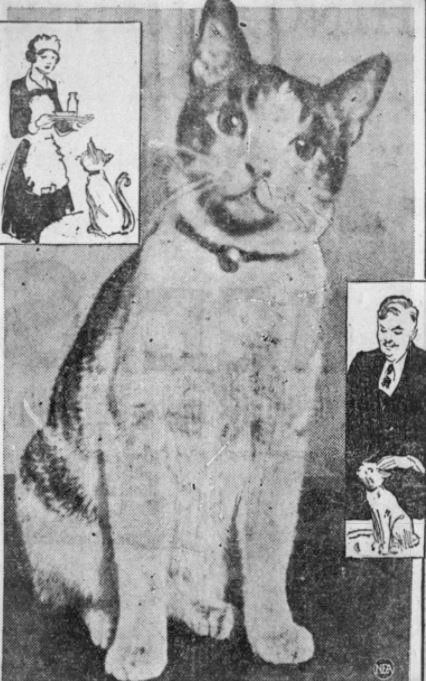
Abe, the mascot cat of New York City’s brand-new Hotel Lincoln at 700 Eighth Avenue. (Wisconsin Daily Tribune, June 25, 1928)
Some studies have shown that where you’re born has a huge impact on how far you’ll go in life. I think the same holds true for cats, especially those who are born in large cities like New York.
When Abe’s mother cat gave birth to three kittens in New York City’s Time Square neighborhood in 1928, she couldn’t have picked a better place to bring her little ones into the world.
I don’t know what possessed her to give birth among the wrecking crews at the corner of Eighth Avenue and 45th Street, but the decision paid off big time for one little guy who would one day be called Abe.
In the spring of 1927, when Abe and his two siblings were born, crews were working frantically to erect a new 30-story hotel on the east side of Eighth Avenue between 44th and 45th Street. They had already demolished the block of old brick-with-brownstone-front buildings, and were now trying to set a record to build a grand hotel on the site.
Before the debris was cleared and the concrete caissons had been sunk, Momma gave birth to three male kittens.
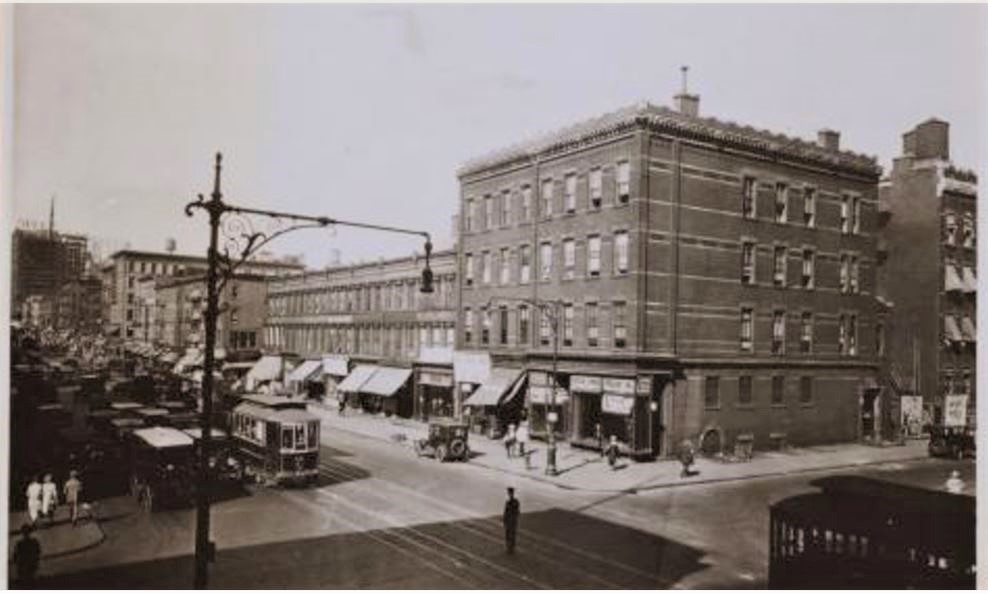
In 1927, all the buildings on the east side of Eighth Avenue between 44th and 45th streets — pictured here in 1925 — were torn down to make room for the Hotel Lincoln. New York Public Library Digital Collections

In 1927 when this photo was taken, construction on the Eighth Avenue subway and the new Hotel Lincoln was in progress. It was on this site that Abe and his brothers came into the world. I don’t know what that odd frame building on 45th Street is, but signs on the foundation are advertising Wings, a silent film about World War I that was showing at the Criterion Theatre on 44th Street in 1927. NYPL Digital Collections
The Farm at Bloomingdale
Let’s step back about 215 years, before the inventions of Thomas Edison turned Broadway and Times Square into the “Great White Way.” Back then, the area of New York City extending along the old Bloomingdale Road (what we call Broadway today) — from 42nd Street to 46th Street and thence northwesterly to the Hudson River — was the property of an Englishman named Medcef Eden. Eden was a farmer, but his onion and potato crops never seemed to do very well. Hence, Medcef was still in debt when he died in 1798.
One day in 1803, William Cutting, the sheriff of the City and County of New York, and a fur merchant with a German accent purchased for $25,000 a one-third interest in an outstanding mortgage on the 70-acre Eden farm. For that price, the two men got 22 acres of land, two dwelling houses, and two barns. Cutting took the western portion of the land and the fur merchant took the eastern section.
Although the Eden heirs in England brought a suit against the sheriff and fur merchant, in the end the buyers prevailed. The fur merchant was, after all, John Jacob Astor.
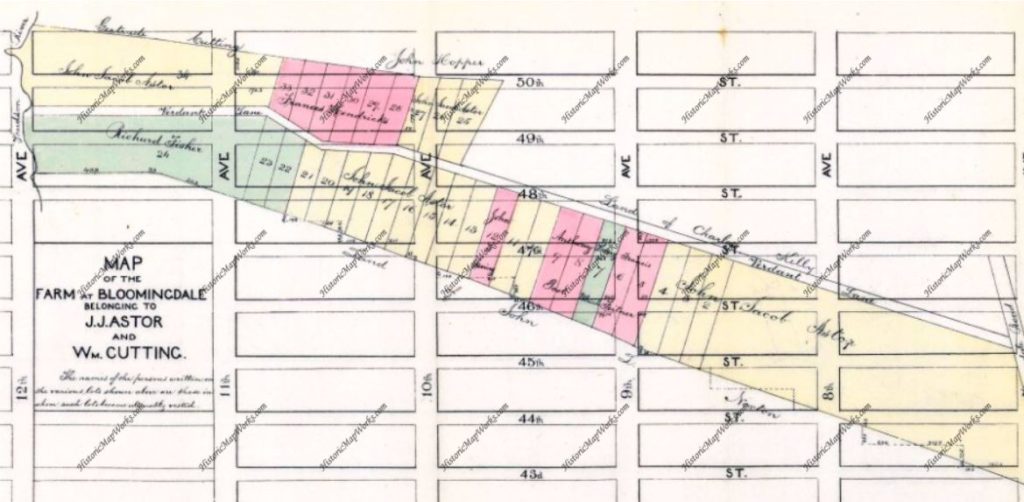
This 1881 farm map shows the boundaries of John Jacob Astor’s and William Cutting’s Farm at Bloomingdale, which they acquired under foreclosure from the Medcef Eden estate for $25,000.
Astor called the land the “Farm at Bloomingdale” for the main road that formed the eastern boundary of the old Eden farm. Opened under the Act of June 19, 1703, the Bloomingdale Road was the continuation of Bowery or New York Lane. The road began at 14th Street and Fourth Avenue, crossed diagonally across Union Square, and proceeded northerly to the Old Post Road, which followed the line of today’s Third Avenue.
The Farm at Bloomingdale, where a mother cat would one day give birth to kittens on a major construction site, was located at the four-mile stone on the Bloomingdale Road. In other words, it was four miles from Federal Hall on Wall Street.
Abe Finds a Home at the Hotel Lincoln
Like his mother, Abe was a white cat with tiger markings. One of his brothers was black with a white star on his breast and the other was mouse-colored. For several weeks after their birth, the steel workers shared their slabs of pork and salami with the mother tabby and her kittens. As news of the litter spread, people from the theater district brought milk and biscuits for the kitties.
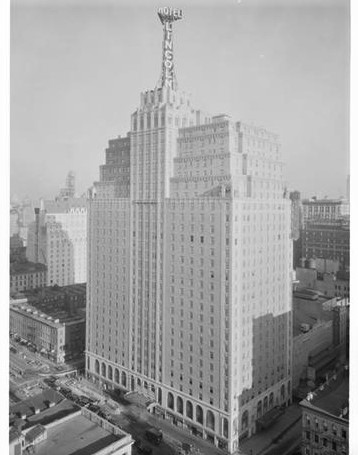
The Hotel Lincoln on Eight Avenue opened on January 31, 1928, just 10 months after construction began. Built by the Chanin Construction Company at a cost of more than $10 million, it was operated by the Chanin interests through James T. Clyde, who was named its managing director. NYPL Digital Collections
When the kittens were big enough to run over the steel girders and Momma cat felt they could be left on their own, she disappeared into the city streets. The black and grey kitten also left the construction site, leaving the white and tiger-striped cat to fend for himself.
As the weeks went by, the construction workers continued to share their lunches with the kitten. Pedestrians and others in the area would stop by to scratch his ears and stroke the fur on his back. Life was good, but winter was coming and what was going to be the largest hotel west of Broadway was almost ready to open for business.
The Hotel Lincoln opened its large bronze doors on January 31, 1928. The new doorman, who took his job very seriously, was not about to let a stray cat through these doors, and so the little kitten sat on the pavement in the falling snow and waited patiently for the right opportunity.
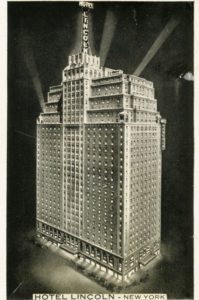
The Hotel Lincoln formerly opened in February 1928 following Lincoln Day exercises in the lobby. At 5 p.m., Governor Al Smith pressed a button at the executive offices in Albany, which illuminated a huge sign on the roof (the top of the sign was 425 feet above the street).
Luckily, it didn’t take long for opportunity to knock. One day when the doorman had turned his back while the doors were open, the brazen kitten jumped inside and scampered up the carpeted stairs. He found a comfy chair on the mezzanine level and took what was the probably the best cat nap in his life.
In Part II, I’ll tell you all about James T. Clyde, the man who saved Abe and gave him a wonderful life at the Hotel Lincoln — and, I may have you singing a 1980s commercial jingle about the “lullaby on Broadway” by the end of this Old New York cat story.




Splendid! Can’t wait for Part II!